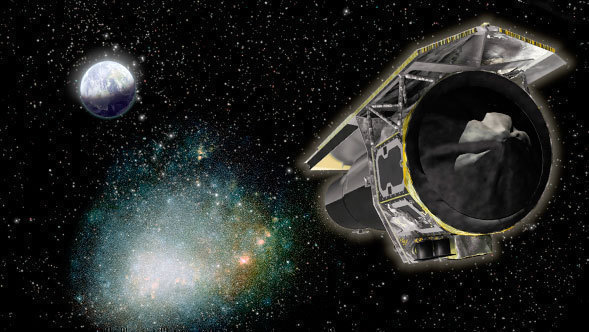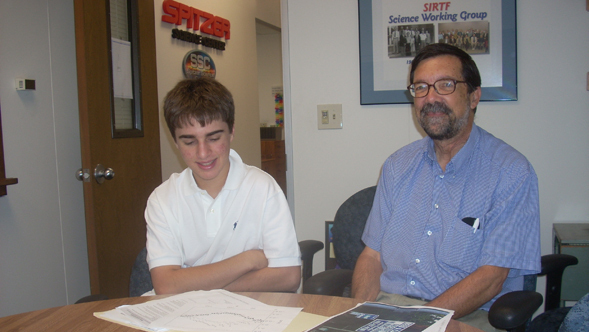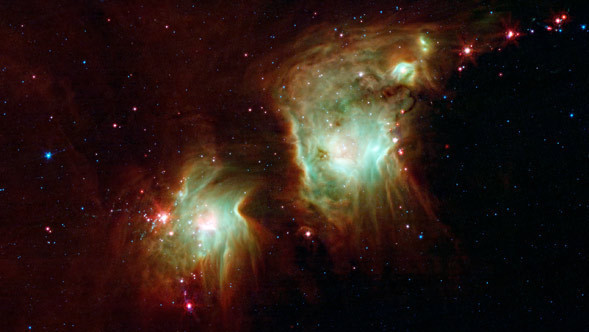
By Gordon Squires | August 25th, 2011
Eight years ago today, I was nervous. Sitting atop a Delta II rocket at Florida's Cape Canaveral Air Force Station, the Spitzer Space Telescope (which was then called the "Space Infrared Telescope Facility" - it was renamed "Spitzer" later that year) was waiting to launch. I've never witnessed a launch in-person, and I didn't travel to Florida to see Spitzer launch either. Instead, I was in an auditorium at Caltech in Pasadena, hosting a launch-viewing event for the general public, and watching the live-feed on NASA TV.
And I was nervous. I remember thinking about all the time, hard work, planning, planning, planning and replanning that had gone in to getting us ready to launch. I had been working with the Spitzer project for 2 years, and I was one of the more junior members of the team. Our project scientist, Mike Werner, had been working on Spitzer for 26 years at that time, and here we were, with the telescope sitting atop a highly explosive rocket, waiting to blast into space. I wondered what was running through his mind? I'll admit there was a small part of me that hoped the launch would be delayed - the prospect of an unsuccessful launch was a thought too horrible to bear. I've often joked I had a briefcase full of resumes with me, in case something bad happened. It's not true, but I think it adds to the story...
Needless to say my fears were not realized. At 1:35:39 a.m. Eastern Daylight Time (10:35:39 p.m. Pacific Daylight Time, August 24) Spitzer launched and was on its way to an incredibly successful mission. Required to perform a 2.5 year mission, 8 years later Spitzer is still operating even better than what was required, and can continue to operate for years to come. Spitzer has been a tremendous success for NASA, and has revolutionized several fields of research in astronomy.
At time of writing, Spitzer has executed over 50,000 hours of science observations. Spitzer is the most efficient space observatory ever flown in terms of science-per-hour, and one of the most cost effective. When launched in 2003, no one had ever detected light from a planet beyond Neptune (sorry Pluto, you don't count), but in 2005, Spitzer did - detecting light from 2 planets, including one that is 153 light-years away. By now it has characterized more planets outside of our solar system than there are planets in our solar system. To me personally, this continues to be one of the most exciting areas of research enabled by Spitzer.
At lunch today, we had a small celebration at the Spitzer Science Center at Caltech. Mike Werner took a poll of how many of us were with the project when Spitzer launched 8 years ago - over half of the current team was with us then, and many have dedicated a large fraction of their professional lives working on Spitzer.
I've also been thinking a lot today about some of the folks who have moved on to other projects, and others who unfortunately passed away. They are missed. It is, and always has been, an incredible team. I've never enjoyed working with a set of folks more than I enjoy working with the Spitzer team. Like the telescope itself, they are the best-of-the-best and make each and every day a joy and a voyage of discovery for me personally. I know I am fortunate to be a part of this special project, and to be a member of this very special team.
So today, as I tip my hat in congratulations to Spitzer, NASA's infrared Great Observatory, and celebrate an incredible telescope and mission, let me also say "thank you" to all the members of the team, past and present. It truly has been the time of my life, and I look forward to many great years ahead.
Happy anniversary, Spitzer!
 All in the Family
All in the Family
 Star Formation Seen through Dust-Covered Glasses
Star Formation Seen through Dust-Covered Glasses



